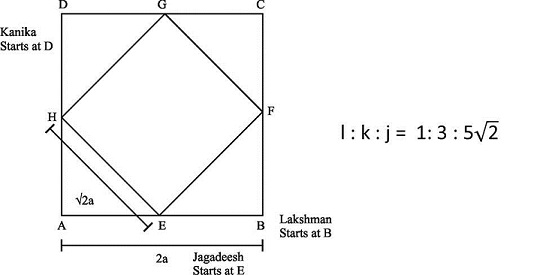CAT Quantitative Aptitude Questions | CAT Time Speed and Distance & Races
CAT Questions | Races | Geometry
The question is from the topic Races. It also involves ideas from Geometry. CAT exam is known to test on multiple ideas in the same question, so you should be ready to face them. Time Speed and Distance is a favorite in CAT Exam, and appears more often than expected in the CAT Quantitative Aptitude section in the CAT Exam
Question 2: Consider a square ABCD. EFGH is another square obtained by joining the midpoints of the sides of the square ABCD where E, F , G amd H are the midpoints of AB, BC, CD and DA respectively. Lakshman and Kanika start from points B and D respectively at speeds ‘l’ kmph and ‘k’ kmph respectively and travel towards each other along the sides of the square ABCD. Jagadeesh starts from Point E and travels along the Square EFGH in the anti-clockwise direction at ‘j’ kmph. Lakshman and Kanika meet for the second time at H where Jagadeesh also meets them for the first time. If l : k : j is 1: 3 : 5√2 then the distance travelled by Jagadeesh is
- 7.5 × √2 times the side of the square ABCD
- 7.5 × √2 times the side of the square EFGH
- 7.5 times the side of the square ABCD
- 7.5 times the side of the square EFGH
🎉 Enrol for the 2IIM GDPI course and avail an exclusive discount.
2IIM : Best Online CAT Coaching.
Best CAT Online Coaching
Try upto 40 hours for free
Learn from the
best!
2IIM : Best Online CAT Coaching.
Video Explanation
Best CAT Coaching in Chennai
CAT Coaching in Chennai - CAT 2022
Limited Seats Available - Register Now!
Explanatory Answer
Method of solving this CAT Question from Races: Lakshman and Kanika meet for the second time at H where Jagadeesh also meets them for the first time √2.

Lakshman and Kanika start from points B and D respectively at speeds ‘l’ kmph and ‘k’ kmph respectively and travel towards each other along the sides of the square ABCD. They are at a distance of 4a from each other. Since they are at diametrically opposite points, the relative distance would be 4a irrespective of the directions they choose to travel in. So, to meet for the first time, they would have travelled a distance of 4a together.
To meet for the second time, they would have travelled a further 8a together. Essentially, between them, they would have to cover the entire perimeter of the square to meet again.
So by the time they meet for the second time, they would have covered a distance of 12a together. Their speeds are in the ratio 1: 3. So, Lakshman would have travelled 3a and Kanika would have travelled 9a.
Or, Lakshman travels in the direction BADC, while Kanika would have travelled in the direction DABC. They meet for the first time at E and the second time at H.
In the same time, Jagadeesh travels along the square EFGH in the anti-clockwise direction at ‘j’ kmph and meets Lakshman and Kanika. While Jagadeesh meets the other two for the first time, we do not know how many laps he has completed by then.
The ratio of Lakshman’s speed to that of Jagadeesh is 1: 5√2 so, they would have travelled distances in the same ratio as well. So, if Lakshman has travelled a distance of 3a, Jagadeesh should have travelled a distance of 3a x 5√2 to reach H.
Or, Jagadeesh travels 52a to reach H. Answer choice (a)
The question is "If l : k : j is 1: 3 : 5√2 then the distance travelled by Jagadeesh is"
Hence, the answer 7.5 × √2 times the side of the square ABCD
Choice A is the correct answer.
CAT Preparation Online | CAT Arithmetic Videos On YouTube
Other useful sources for Arithmetic Question | Time Speed Distance and Races Sample Questions
CAT Questions | CAT Quantitative Aptitude
CAT Questions | CAT DILR
CAT Questions | Verbal Ability for CAT
Copyrights © All Rights Reserved by 2IIM.com - A Fermat Education Initiative.
Privacy Policy | Terms & Conditions
CAT® (Common Admission Test) is a registered trademark of the Indian
Institutes of Management. This website is not endorsed or approved by IIMs.
Where is 2IIM located?
2IIM Online CAT Coaching
A Fermat Education Initiative,
58/16, Indira Gandhi
Street,
Kaveri Rangan Nagar, Saligramam, Chennai 600 093
How to reach 2IIM?
Phone: (91) 44 4505 8484
Mobile: (91) 99626 48484
WhatsApp: WhatsApp Now
Email: prep@2iim.com



